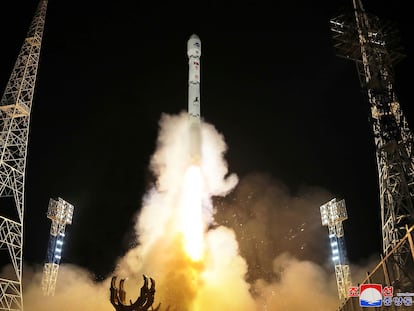Japan issues tsunami warnings after a series of strong earthquakes on Sea of Japan coast
The Japan Meteorological Agency reported quakes on the Sea of Japan coast hitting Ishikawa and nearby prefectures Monday, one of them with a preliminary magnitude of 7.6
Japan issued tsunami alerts and told people to evacuate seaside areas after a series of strong quakes on its western coastline Monday.
The Japan Meterological Agency reported quakes off the coast of Ishikawa and nearby prefectures shortly after 4 p.m., one of them with a preliminary magnitude of 7.6.
It issued a major tsunami warning for Ishikawa and lower-level tsunami warnings or advisories for the rest of the western coast of Japan’s main island of Honshu.
Japanese public broadcaster NHK TV warned torrents of water could reach as high as 5 meters (16.5 feet) and urged people to flee to high land or the top of a nearby building as quickly as possible.
NHK said the tsunami waves could keep returning, and warnings were continuing to be aired more than two hours after the initial alert. Several aftershocks also rocked the region.
Government spokesman Yoshimasa Hayashi told reporters that nuclear plants in the area had not reported any irregularities. But he said it was critical for people in coastal areas to get away from the oncoming tsunami.
“Every minute counts. Please evacuate to a safe area immediately,” he said.
A tsunami of about 3 meters (about 10 feet) high was expected to hit Niigata and other prefectures on the western coast of Japan. Smaller tsunami waves were already confirmed to have reached the coastline, according to NHK.
The earthquakes themselves also caused damage. Japanese news footage showed reddish smoke spewing from an area in Wajima city, Ishikawa Prefecture, noting there could be a fire there. Details were not immediately available.
A house had crumbled in another area, and a search was underway to see if people were trapped in the rubble.
Bullet trains in the area were halted. Parts of the highway were also closed, and water pipes had burst, according to NHK.
Japanese media reports showed a crowd of people, including a woman with a baby on her back, standing by huge cracks that had ripped through the pavement.
The Meteorological Agency said in a nationally broadcast news conference that more major quakes could hit the area over the next week, especially in the next two or three days.
Tsunami warnings were also issued for Japan’s northernmost main island of Hokkaido and for parts of North Korea and Russia. Russian officials issued a tsunami alert for the island of Sakhalin, warning that areas across the island’s west coast could be affected by the waves.
In nearby South Korea, the weather agency urged residents in some eastern coastal towns to watch for possible changes in sea levels. Tsunami waves that hit later later can be bigger than the initial ones.
The Japanese government has set up a special emergency center to gather information on the quakes and tsunami and relay them speedily to residents to ensure safety, Prime Minister Fumio Kishida told reporters.
He reiterated the warning for immediate evacuation in affected areas.
Japan is an extremely quake-prone nation. In March 2011, a major quake and tsunami caused meltdowns at a nuclear plant.
Sign up for our weekly newsletter to get more English-language news coverage from EL PAÍS USA Edition
Tu suscripción se está usando en otro dispositivo
¿Quieres añadir otro usuario a tu suscripción?
Si continúas leyendo en este dispositivo, no se podrá leer en el otro.
FlechaTu suscripción se está usando en otro dispositivo y solo puedes acceder a EL PAÍS desde un dispositivo a la vez.
Si quieres compartir tu cuenta, cambia tu suscripción a la modalidad Premium, así podrás añadir otro usuario. Cada uno accederá con su propia cuenta de email, lo que os permitirá personalizar vuestra experiencia en EL PAÍS.
¿Tienes una suscripción de empresa? Accede aquí para contratar más cuentas.
En el caso de no saber quién está usando tu cuenta, te recomendamos cambiar tu contraseña aquí.
Si decides continuar compartiendo tu cuenta, este mensaje se mostrará en tu dispositivo y en el de la otra persona que está usando tu cuenta de forma indefinida, afectando a tu experiencia de lectura. Puedes consultar aquí los términos y condiciones de la suscripción digital.
More information
Últimas noticias
Most viewed
- Sinaloa Cartel war is taking its toll on Los Chapitos
- Oona Chaplin: ‘I told James Cameron that I was living in a treehouse and starting a permaculture project with a friend’
- Reinhard Genzel, Nobel laureate in physics: ‘One-minute videos will never give you the truth’
- Why the price of coffee has skyrocketed: from Brazilian plantations to specialty coffee houses
- Silver prices are going crazy: This is what’s fueling the rally










































